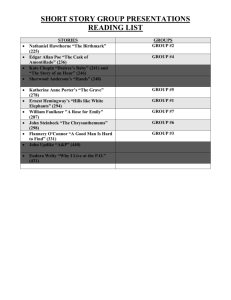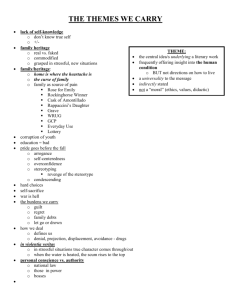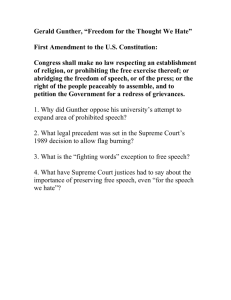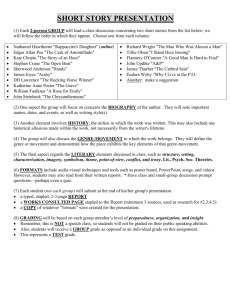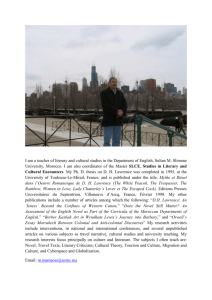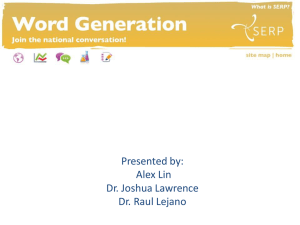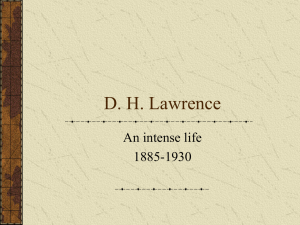EUROPEAN ACADEMIC RESEARCH, VOL
advertisement
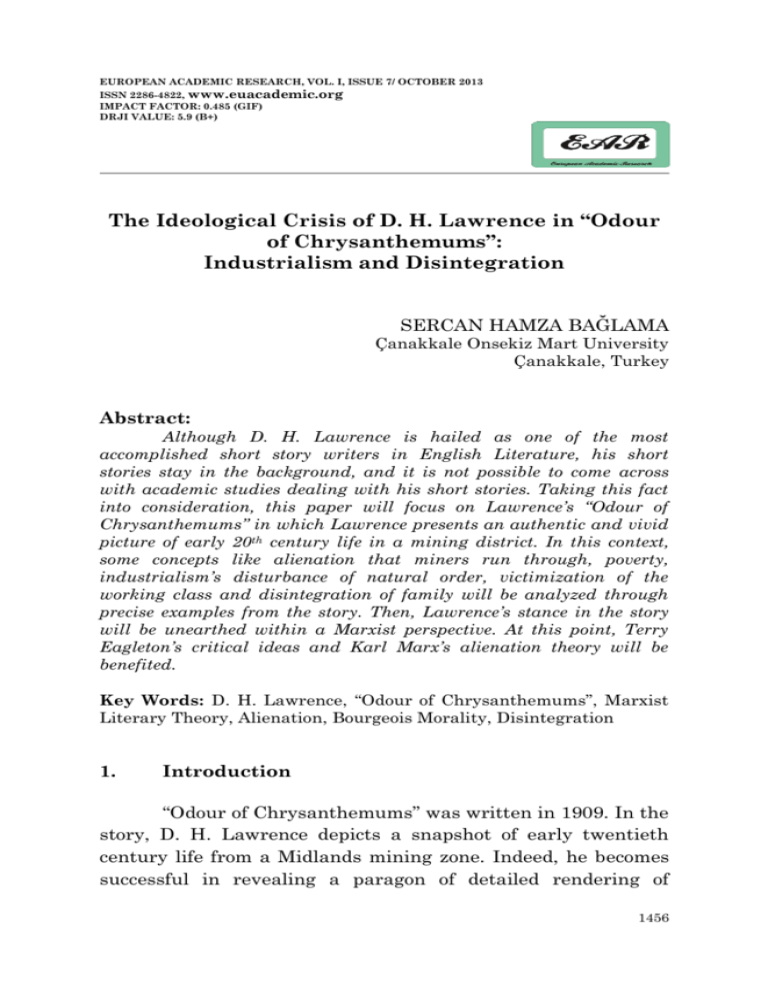
EUROPEAN ACADEMIC RESEARCH, VOL. I, ISSUE 7/ OCTOBER 2013 ISSN 2286-4822, www.euacademic.org IMPACT FACTOR: 0.485 (GIF) DRJI VALUE: 5.9 (B+) The Ideological Crisis of D. H. Lawrence in “Odour of Chrysanthemums”: Industrialism and Disintegration SERCAN HAMZA BAĞLAMA Çanakkale Onsekiz Mart University Çanakkale, Turkey Abstract: Although D. H. Lawrence is hailed as one of the most accomplished short story writers in English Literature, his short stories stay in the background, and it is not possible to come across with academic studies dealing with his short stories. Taking this fact into consideration, this paper will focus on Lawrence’s “Odour of Chrysanthemums” in which Lawrence presents an authentic and vivid picture of early 20th century life in a mining district. In this context, some concepts like alienation that miners run through, poverty, industrialism’s disturbance of natural order, victimization of the working class and disintegration of family will be analyzed through precise examples from the story. Then, Lawrence’s stance in the story will be unearthed within a Marxist perspective. At this point, Terry Eagleton’s critical ideas and Karl Marx’s alienation theory will be benefited. Key Words: D. H. Lawrence, “Odour of Chrysanthemums”, Marxist Literary Theory, Alienation, Bourgeois Morality, Disintegration 1. Introduction “Odour of Chrysanthemums” was written in 1909. In the story, D. H. Lawrence depicts a snapshot of early twentieth century life from a Midlands mining zone. Indeed, he becomes successful in revealing a paragon of detailed rendering of 1456 Sercan Hamza Bağlama– The Ideological Crisis of D. H. Lawrence in “Odour of Chrysanthemums”: Industrialism and Disintegration reality as suggested by Werner Hüllen. He also makes the reader envisage a great many details of setting and thereby criticizes industrialism along with its poisonous impacts upon the lives of miners and their families. Lawrence’s framework of the narrative incorporates symbols which enable the depiction of reality through details. At this point; Volker Schulz in his article states that by shifting the focus several times between the mining town’s environment dominated by the colliery, the mining town with its row of small houses and its pubs, the kitchen and parlor of the Bates’ house, and the kitchen of another miner’s house, the author succeeds in making the reader visualize many details of setting as well as accentuating the main features of the miners’ and their families lives. (Schulz 1991: 363) “Odour of Chrysanthemums” technically reflects “Lawrencean” thematic and perceptional characteristics like industrialism, alienation and mechanization as well (Tedlock 1963: 26). According to Tedlock, this short story is an example of Lawrence’s art at its organic best, and a felt meaning of cumulative fatality is climatically realized through tone, setting, dialogue, action, a suggestive imagery of deathliness through ragged garden, autumn and odor of chrysanthemums (Tedlock 1963: 26-7). For that reason, a conceptual analysis is needed so that the real nature of this story could be unveiled and deciphered. In “Odour of Chrysanthemums”, Elizabeth Bates is the main focus of the story. She is “a tall woman of imperious mien, handsome, with definite black eyebrows” (284), determined wife of a miner and struggling against difficult circumstances to be able to bring her two young children, John and Annie, up. In fact, there are three major stages in this story, which could successively be entitled as waiting, searching and death. In the first part of the story, a mining village is described with its sights and sounds. Then, Elizabeth is seen to be upset since her husband has not come from work, and she feels that he is drunk at the pub as usual. She becomes angry at her husband’s recklessness and negligence. In the second part of the story, Elizabeth Bates becomes worried and goes out to seek her husband. Initially, she asks her neighbors. Then, Mr. Rigley EUROPEAN ACADEMIC RESEARCH, VOL. I, ISSUE 7/ OCTOBER 2013 1457 Sercan Hamza Bağlama– The Ideological Crisis of D. H. Lawrence in “Odour of Chrysanthemums”: Industrialism and Disintegration begins to search for his partner. Meanwhile, everyone thinks that Mr. Bate is probably drunk in a pub. It is also thought that he might be injured, but this is not put into words. In the last part of the story, the men from the mine come and bring the dead body of Walter, and it becomes certain that Walter is dead. And these men leave after putting Walter’s body in the parlor. Mrs. Bates starts to reevaluate the worth of his husband and their lives while washing the death body of her husband with her mother-in-law. In this point, she ironically realizes that they never had a chance to know each other and both of them are responsible for the failure of their marriage. Volker Schulz argues that there are two main contributions of Lawrence in “Odour of Chrysanthemums” to the British literature. One of these contributions is the “portrayal of the working-class in a mining district” as a result of which Lawrence was regarded as “the classic novelist of the English workers” (Hough 1970: 170). The other one is related with the “subtle and unflinching exploration of love relationships” (Schulz 1991: 364). In this respect, “Odour of Chrysanthemums” can initially be analyzed from a Marxist point of view. In the story, industrial corruption along with poverty, alienation and disturbance of natural order, victimization of the working-class people and the disintegration of family caused by industrialism are in essence criticized through details, symbols, imagery and metaphors. As a consequence of the fact that D. H. Lawrence makes use of these aesthetics of literature, it is possible to argue that Lawrence applies highly visible symbols and therefore employs symbolic realism. Secondly, “Odour of Chrysanthemums” can be studied from a husband and wife relationship perspective which decays and is rearranged in relation with industrialism. Meanwhile, it is also necessary to refer to the historical context of the short story in relation with the condition of the British Empire and industrialism so that the realistic nature of the story could be revealed. “Odour of Chrysanthemums” was written at the turn of the century. At that time, British Empire was still a huge empire both militarily and industrially. As well as many colonies to which goods were exported, factories generally located in the northern part of England were in abundance. The major energy source of these factories was coal. EUROPEAN ACADEMIC RESEARCH, VOL. I, ISSUE 7/ OCTOBER 2013 1458 Sercan Hamza Bağlama– The Ideological Crisis of D. H. Lawrence in “Odour of Chrysanthemums”: Industrialism and Disintegration However, the sites in which coal was extracted were depressing and bleak. People working in this job had despairing lives. They were living near coal pits in dust and grime as part of their lives. They often comforted themselves in pubs to forget threatening life conditions and anxiety. Thus, working-class people were in trouble with alcoholism. All these scenes from the 20th British Empire are viewed in Lawrence’s “Odour of Chrysanthemums” as can be deduced from the summary above. In addition, the setting of the story is associated with real place names. For example, some names around Eastwood like Brinsley are seen in the story. In this context, Paul Poplawski points out that Actual place-names in the vicinity of Eastwood are used. The Bates' cottage is by the railway crossing at Brinsley, a mile north of Eastwood and south of Underwood and Selston Colliery, which are also mentioned in the story . . . the cottage here is based on Quarry Cottage, Lawrence's grandfather's cottage, later his uncle's, at Brinsley; and the death of Walter Bates . . . is based on the death of Lawrence's uncle, James Lawrence, in a fall of coal at Brinsley Colliery on 17 February 1880. (Poplawski 1996: 309) Lawrence’s using such actual place names and his depiction of the real conditions in England also contributes to the persuasiveness and credibility of the story. And these are among the other characteristics that promote Lawrence to be located as “the classic novelist of the English workers” in English literature (Hough 1970: 170). 2. Industrial Corruption Corruption related with industrialism is revealed through the alienation process of the working-class people, their monotonous and mechanic life, poverty and disturbance of natural order. As elucidated above, symbolic or metaphorical language is of utmost importance as the concept of realism is indirectly suggested and implicated. The story takes place in Brinsley Colliery, the industrial base of a coal-mining district. Throughout the story, there is an imagery of darkness that covers everything. Lawrence presents us a dreary picture in which terrible influences of industrialism upon natural environment is depicted. A bleakness and blight EUROPEAN ACADEMIC RESEARCH, VOL. I, ISSUE 7/ OCTOBER 2013 1459 Sercan Hamza Bağlama– The Ideological Crisis of D. H. Lawrence in “Odour of Chrysanthemums”: Industrialism and Disintegration prevail the story. The story opens with rich symbols. For example, Lawrence, in the first sentence, chains “the small locomotive” (283) with a colt that “startled from among the gorse, which still flickered indistinctly in the raw afternoon” (283). That colt in the story runs faster than the “clanking, stumbling” train (283). According to Cai Yamin, this colt is a symbol of a young and natural life-force while train is symbolizing a slow and mechanical machine which is a more powerful and dominant force in the landscape (Yamin 2007: 15). Again in the first paragraph, Lawrence introduces a woman who “stood insignificantly trapped between the jolting black wagons and the hedge” (283). In this sentence, this woman is depicted as “insignificantly trapped” between the two, and she symbolizes human captivity under the machines of industrialism: … the reader may assume that whatever is natural, even though superior to the mechanical, has been relegated to a background of indistinctness, for the colt is faster than the engine and the woman represent the humanity that is pushed aside by machines. (Yamin 2007: 15) There is not anything positive in the first paragraph. “The fields” are “dreary and forsaken” (283), and “withered oak leaves” drop “noiselessly” (283) among polluted and smokecleaved “rough grass” (283). People, “at the mercy of the machine, also breathe an atmosphere of death” (Sagar 1966: 15). In these descriptions, withered oak leaves dropping noiselessly might allude to the passivity of the working-class that is pining away. In addition, the sentence “The engine whistled as it came into the wide bay of rail-way lines beside the colliery, where rows of trucks stood in harbor” (283) suggests the opposition between industrialism and nature. Mechanical industrialism has to build harbors so that it might prevent the rebellion of the nature and protect it against the destruction of industrialism. Likewise, miners in the story who, “single, trailing and in groups, passed like shadows diverging home” (283) also reveal the insignificancy and mechanization of the working-class people. The depiction of the landscape around the cottage is full of negative connotations as well. For instance, the cottage, where Bates family is living, is “three steps from the cinder EUROPEAN ACADEMIC RESEARCH, VOL. I, ISSUE 7/ OCTOBER 2013 1460 Sercan Hamza Bağlama– The Ideological Crisis of D. H. Lawrence in “Odour of Chrysanthemums”: Industrialism and Disintegration track” (283). This metaphorically stands for the fact that working-class people do not live at the same level with the bourgeois class. They are doomed to live where there are “twiggy tress” (283) and “disheveled pink chrysanthemums” (284). We also see “a large bony vine” which clutches “at the house, as if to claw down the tiled roof” (293). This shows that “nature is death-like, grasping for life in its final moments, for living things are depleted and malnourished” (Yamin 2007: 15). All these depictions of nature, a result of nature’s exploitation by industrialism, include negative allusions. 2.1. Poverty The poverty of the working-class people in the story is also revealed through metaphors and symbols. That is, target message is imposed upon the reader’s unconscious level by implicit suggestions through aesthetics of language. In this way, the optimistic atmosphere of the money-oriented world is dismantled, and doubts are impregnated about the real nature of the bourgeoisie. This is what Lawrence achieves consciously or unconsciously in this story. Some examples from the story might be useful. For example, the clothes of John “were evidently cut down from a man’s clothes” (284). Accordingly, Elizabeth Bates comes across with many rats “with which the place was over-run” in the yard (290) while she begins to seek for her husband. At that point, she goes up to Mr. Rigley to find out whether he knows where her husband is or not, and she steps into his house. There, what she faces is worth focusing since it suggests strait life conditions of Rigley family: The kitchen needed apology. There were little frocks and trousers and childish undergarments on the squab and on the floor, and a litter of playthings everywhere. On the black American cloth of the table were pieces of bread and cake, crusts, slops, and a teapot with cold tea. (291) Upon seeing these, Elizabeth comforts them by saying “Eh, ours is just as bad” (291). However, after sitting, Elizabeth views “twelve shoes” and a “general untidiness of the room” with “a bit of carpet” (291). John’s having “badly fitting old clothes” (291), yard’s being overrun by rats, pathetic and miserable condition of Mr. EUROPEAN ACADEMIC RESEARCH, VOL. I, ISSUE 7/ OCTOBER 2013 1461 Sercan Hamza Bağlama– The Ideological Crisis of D. H. Lawrence in “Odour of Chrysanthemums”: Industrialism and Disintegration Rigley’s house along with a huge population can be recounted as the symbols of poverty. Through such emblematic descriptions and imageries, the life conditions of the lower-class people are revealed in an objective and implicit way which is called as objective partisanship in Marxist literary terminology: “The political tendency must emerge unobtrusively from the dramatized situations; only in this indirect way could revolutionary fiction would work effectively on the bourgeois consciousness of its readers” (Eagleton 2002: 43). Meanwhile, it is an interesting detail that Rigley family has a great many children though they do not seem to have enough income. This is linked with the fact that the function of lower-class people under capitalism is to provide bourgeois class with new proletarians and sustain future labor source. In this sense, this fact is criticized by Lawrence. 2.2. Darkness, Fire and Alienation As pointed out in the beginning, there is an atmosphere of darkness throughout the story. Natural light is only seen for a short period. After sun disappears, there is an artificial light at homes, which is mainly sustained through coal. According to Schulz, Bates’ house initially seems to be bright and warm: “The kitchen was small and full of firelight; red coals piled glowing up the chimney mouth. All the life of the room seemed in the white, warm hearth and the steel fender reflecting the red fire” (286). The impression given by this description could be associated with that: Life exists in the fire. However, after a while it is stated that “Indoors the fire was sinking and the room was dark red” (286). This case points to the fact that fire is slowly fading away and losing its energy of life. Then, Elizabeth drops “piece after piece of coal on the red fire, the shadows fell on the walls, till the room was almost in total darkness” (288). And this reveals that fire dies and is suffocated and smothered under coal. In this context, this gloominess alludes to the darkness in the mines. As known, Walter Bate is alive in the beginning, however he is dead at the end of the story. Actually, this is connected with the fire fading away in the house. When Walter dies, Elizabeth is told that he was trapped in the coal mine as a consequence of a cave-in and asphyxiated because of lack of oxygen. Likewise, in the story, Elizabeth puts pieces of coal on the fire, yet that fire slowly EUROPEAN ACADEMIC RESEARCH, VOL. I, ISSUE 7/ OCTOBER 2013 1462 Sercan Hamza Bağlama– The Ideological Crisis of D. H. Lawrence in “Odour of Chrysanthemums”: Industrialism and Disintegration stops burning. Like Walter, the fire in the house dies. That fire is suffocated and smothered by a layer of coal. Through this metaphor, it is also implicated that industrialism eventually will use up all coal, the main source of energy, and human beings and humanity will be suffocated. The concept of darkness in the story is also related with the industrial darkness. For example, some expressions like “garden and fields beyond the brook were closed in uncertain darkness” (286), “darkness was settling over spaces of the railway and truck: the miners, in grey somber groups, were still passing home” (286) and “the night was very dark, in the great bay of railway lines, bulked with trucks, there was no trace of light” (290) reveal an interesting detail. Everything associated with industrialism seems to be dark in the story. To exemplify, pit-ponds beyond the brook, trucks and railway lines are all elements of industrialism, and they are, in each time, envisaged with gloomy connotations. In this way, Lawrence argues that industrialism darkens our environment and humanity. Another striking point is alienation process in the story. An important example of this process in the story is that: Elizabeth asks Rigley family for help while she seeks for her husband. At that time, Mrs. Rigley, “the woman across the yard” is “standing at her door listening, but she” does not “care” (291). She does not care what is going on around her since she lacks emotion and senses. In this situation, we see some pettybourgeois tendencies like egoism and selfishness along with an example of the final aspect of estrangement in which persons are alienated to each other under industrial capitalism. In alienation theory of Marx, individuals are respectively alienated to the product of their work, to the working process, to their human nature and to each other: “An immediate consequence of the fact that man is estranged from the product of his labor, from his life activity, from his species-being, is the estrangement of man from man” (Marx 1844: 32). Another explicit example of alienation and mechanization under industrialism is Walter’s habit of drinking. When Walter disappears, Elizabeth initially thinks that he is as usual out for drinking. Indeed, this is essentially linked with Marxist escapism clarified by Marx in Critique of Hegel’s Philosophy of Right. When Marxist escapism in this EUROPEAN ACADEMIC RESEARCH, VOL. I, ISSUE 7/ OCTOBER 2013 1463 Sercan Hamza Bağlama– The Ideological Crisis of D. H. Lawrence in “Odour of Chrysanthemums”: Industrialism and Disintegration work is taken into account, it is seen that Marxist escapism is primarily about religious suffering and escapism: Religious suffering is, at one and the same time, the expression of real suffering and a protest against real suffering. Religion is the sigh of the oppressed creature, the heart of a heartless world, and the soul of soulless conditions. It is the opium of the people. The abolition of religion as the illusory happiness of the people is the demand for their real happiness. (Marx 1843/44: 3) However, the main point about religious escapism is that it prevents individuals from becoming aware of the happenings around them. In this respect, the escapism theory of Marx can be adapted to other situations that hinder persons to be aware of the realities under industrial capitalism. Considering this argument, Walter does not want to face with reality in the story. Instead, he mechanically drinks in pubs which are “always warm enough” (287). His awareness of the injustices is numbed by the comfort of pubs. As a consequence of this, an illusion, that is, a false consciousness is created, and he escapes from reality. And this is a characteristic of pettybourgeois morality as stated by Ossowska in her book entitled Bourgeois Morality: Peace at any price (Ossowska 2004: 20). 2.3. Victimization of People Victimization of people under industrial corruption is another essential argument of the story. Again, these are suggested through symbols and metaphors. First of them is the episode in which the dead body of Walter is brought by the representatives of the mine company. After putting Walter’s body on parlor, that representative says: “It is the most terrible job I’ve ever known. Seems as if it was done o’ purpose. Clean over him, an’ shut ‘im in, like a mouse trap” (297). Actually, […] the firm’s representative tries to put off the responsibility for the accident to some unknown superhuman power (done o’ purpose), the symbolism of the opening paragraph as well as Mr. Rigley’s “blue scar” makes it quite clear that such accidents are part and parcel of the industrial system. (Schulz 1991: 365) Another detail employed by D. H. Lawrence is pit banks. These pit banks are used as “a mound of waste materials EUROPEAN ACADEMIC RESEARCH, VOL. I, ISSUE 7/ OCTOBER 2013 1464 Sercan Hamza Bağlama– The Ideological Crisis of D. H. Lawrence in “Odour of Chrysanthemums”: Industrialism and Disintegration extracted from the mine and separated from the precious coal” (Blythe and Sweet 2002: 154). When Walter’s dead body is brought, his insignificance is realized by readers if pit bank metaphor in the story is taken into account: “Walter, a nameless and faceless laborer, was dead in the wombcave where he worked and is brought out of the mine as dark and as dead as the materials in the pit bank” (Blythe and Sweet 2002: 154). This fact, Walter’s being nameless and faceless, is similar to Charles Dickens’ “hands” metaphor in Hard Times (61). In that metaphor, workers are just seen as hands; they do not have names or personalities. They are seen as a mere source of labor. Likewise, in “Odour of Chrysanthemums”, Walter does not have a personal value, and he deserves to be thrown away since he has lost his function as a worker. 2.4. Chrysanthemums Lawrence often employs the imagery of chrysanthemum flower which alludes to several meanings in the story. Although chrysanthemums are associated with positive meanings like happiness and life in many different countries and cultures, they are linked with negative connotations like unpleasantness and death in the story. For example, some petals in the garden are broken off by John, and Mrs. Bates walks through “disheveled” (284) pink chrysanthemums while Annie is pushed away when she tries to smell the chrysanthemums in her mother’s apron. Likewise, Walter is brought home drunk in one situation in which he has brown chrysanthemums in his buttonhole. A vase of chrysanthemums also falls down and is broken when the death body of Walter is brought home on a board. In addition, Elizabeth says: “It was chrysanthemums when I married him, and chrysanthemums when you were born, and the first time they ever brought him home drunk, he’d got brown chrysanthemums in his button-hole” (289). As a matter of fact, in each case, chrysanthemums are metaphorically used and have different meanings. Basically, “chrysanthemums are used repeatedly to symbolize ‘the cycle of birth, marriage, defeat and drunkenness, and death’s associated with the marriage of Walter and Elizabeth Bates” (Rivers 2011: 120). EUROPEAN ACADEMIC RESEARCH, VOL. I, ISSUE 7/ OCTOBER 2013 1465 Sercan Hamza Bağlama– The Ideological Crisis of D. H. Lawrence in “Odour of Chrysanthemums”: Industrialism and Disintegration In this context, the brown chrysanthemums also symbolize the life fading away along with the destruction of life as a consequence of corruption whereas the broken vase is the explicit metaphor of Walter’s death. The broken vase of chrysanthemums can also be taken into consideration from a husband-wife relation in which its shattering leads Elizabeth to self-realization and questioning of her marriage in details. In this sense, chrysanthemums are attributed with a positive meaning for the first time. Furthermore, what chrysanthemums suggest within the context of husband-wife relationship is also of significance. Indeed, these chrysanthemums are the “markers of the deathin-life marriage of Mr. and Mrs. Bates” (Schulz 1991: 368). After the vase is broken, “Mrs. Bates’ eagerness to remove “the broken vase and the flowers” and to mop up “the water with a duster” can be taken as a symbol of her subsequent clearing away of the broken pieces of her wrecked marriage” (Schulz 1991: 368). For that reason, she turns “away from the irreparable failure of her married life toward a vague hope of finding fulfillment as a mother” (Schulz 1991: 368). This struggle of Elizabeth symbolizes her turning to life and finding a kind of satisfaction and fulfillment as a woman as explored by Schulz (368). 3. Disintegration of Chrysanthemums” Family in “Odour of Details related with industrialism’s impact upon common people, though they are initially viewed as unimportant, are vital. The criticism towards industrial corruption is implicitly suggested through these metaphorical and symbolic details instead of being explicitly imposed. Furthermore, as Yamin argues: although the depictions of the dreary landscape caused by the industry at the beginning of the story at first seem to just serve as a background or setting for a more particular story to follow, it soon becomes clear to the reader that those descriptions metaphorically detail the life of Elizabeth Bates, who is losing her own nature amid the same destructive forces that killed her husband. (Yamin 2007: 15) EUROPEAN ACADEMIC RESEARCH, VOL. I, ISSUE 7/ OCTOBER 2013 1466 Sercan Hamza Bağlama– The Ideological Crisis of D. H. Lawrence in “Odour of Chrysanthemums”: Industrialism and Disintegration In this regard, it is essential to focus upon husband-wife relationship in “Odour of Chrysanthemums” in association with alienation and mechanization concepts. In the story, the death of Walter Bates is the dramatic moment in the life of Elizabeth as she becomes aware that they are really different from each despite being tied to each other by marriage. Although Elizabeth is initially happy and “felt familiar with him” (301) in her marriage, she gradually feels that they do not utterly know each other. After the accidental death of Walter, Elizabeth finds an opportunity to evaluate her marriage and runs through a self-realization process in which she notices her sense of alienation and isolation; and “death”, in a way, restores “the truth” (301) which lays bare that their marriage was “an erotic failure and she [Elizabeth] had been fighting a husband who did not exist” (Yamin 2007: 14). In the light of this brief introduction, there are two kinds of approaches to husband-wife relationship in “Odour of Chrysanthemums”. First of them is the mechanization and alienation of their marriage. As an outcome of this process, it is revealed that there is no true love between Walter and Elizabeth. As to the second one, it is about traditional family structure as revealed in the story. A number of snapshots in the story related with the first approach could be seen. For example, Elizabeth seems to be calm and, in some ways, indifferent while washing the dead body of her husband, “the naked man, the “other being” (301). She looks at the naked body of her husband and ponders upon her marriage; and she finds out that she did not have an opportunity to know more about her husband: “And she knew what a stranger he was to her” (300), “there has been nothing between them, and yet they had come together, exchanging their nakedness repeatedly” (300), “she knew she had never seen him, he had never seen her, they had met in the dark and had fought in the dark, not knowing whom they met not whom they fought” (300), “she had said he was something he was not” (301). These sentences prove that they are alienated to each other, the final aspect of estrangements, and they are mechanically living in a pointless way which is dictated and imposed by the ruling class considering the concept of Marxist alienation. EUROPEAN ACADEMIC RESEARCH, VOL. I, ISSUE 7/ OCTOBER 2013 1467 Sercan Hamza Bağlama– The Ideological Crisis of D. H. Lawrence in “Odour of Chrysanthemums”: Industrialism and Disintegration By focusing upon husband-wife relationship, Lawrence is probably revealing the isolation of Elizabeth who was “destroyed by the unnaturalness forced upon them by machinery, industrialism” and “lost her husband to the very industrialization that is destroying the countryside” (Yamin 2007: 16). It is also possible to allege that “for Elizabeth, the state of her husband’s death boy crystallizes the distance between them in life” (Marshall 2003: 21) Likewise, Elizabeth comes across with a staggering reality that she only knew the dead body of her husband, had no “knowledge of his true existence-his soul” (Zhen 2008: 103) and feels “the utter isolation of the human soul” (299). Indeed, alienation between Walter and Elizabeth is seen from the beginning of the story. While Elizabeth waits for Walter to come at night, she regrets marrying him: “what a fool I’ve been, what a fool! And this is what I came here for, to this dirty hole, rats and all, for him to slink past his very door” (289). This, in one respect, foreshadows the tragic end of the story which is symbolized through a vase of chrysanthemums that is knocked down and broken leaving “cold, deathly smell” (296) in the room. In fact, according to Volker Schulz, there are three stages that Mrs. Bates is running through (Schulz 1991: 367). When Elizabeth is faced with the death of her husband, this leads her to a penetrating and disillusioning analysis of her marriage as well as influencing her central orientation and conception related with life. Initially, Elizabeth feels the loss of her husband: “He was dead … Her life was gone like this” (300). Similarly, she has a child within her, and this represents the basic life force, which is “a weight apart from her” (299). Secondly, she feels the growing awareness of the failure of her marriage as a result of which Elizabeth senses its product, their unborn child; and this leads Elizabeth to notice different paths for which they, she and her husband, are destined. She begins to think that her life is not finished and she should go on with her life, only an “episode of her life closed” (301). Thirdly, she turns towards life: There were the children- but the children belonged to life” (301). In this point, she tries to find a new meaning in her life as a mother. Her husband is separated from her by an “infinite … gap” (302), and she has to clutch on the life. By taking these into consideration, it can be pointed out EUROPEAN ACADEMIC RESEARCH, VOL. I, ISSUE 7/ OCTOBER 2013 1468 Sercan Hamza Bağlama– The Ideological Crisis of D. H. Lawrence in “Odour of Chrysanthemums”: Industrialism and Disintegration that “the dead husband . . . represents the force of destruction and death that nobody can ultimately escape, while the unborn child represents that force of life from which Mrs. Bates had been alienated for many years” (Schulz 1991: 367). The second approach to “Odour of Chrysanthemums” is about the traditional family structure which is presented through Elizabeth and Walter. They seem to be behaving in parallelism with gender roles ascribed to them by society. For example, after the death of Walter, Elizabeth begins to think about her future as a mother and as a housewife because Walter, “father of her children” (301), is viewed as bread-winner by her. Besides, it is seen that she has domestic responsibilities such as cooking, cleaning, childrearing, making her husband ready for work and so on. In this respect, it can be asserted that Elizabeth fits to feminine stereotypes that require her “to be passive and submissive, suited to a life of domestic and family responsibilities” (Heywood 1992: 226). It is also given that they “were only channels through which life had flowed to issue in the children” (301); and they are viewed only as child-producing machines. Hence, it is possible to argue that Elizabeth and Walter, Lawrencean characters, appear to have interiorized gender roles imposed on them by the system and do not react against it. 4. Conclusion In “Odour of Chrysanthemums”, Lawrence criticizes industrial capitalism and suggestively condemns its extensions like a Marxist. He satirizes alienation, disturbance of natural order and disintegration caused by industrialism. Yet, at the end of the story, the institution of family is disintegrated with the death of Mr. Bates. In fact, what causes the disintegration of family is substantially related with industrial tyranny. Mr. Bates is trapped in the coal mine and dies as a result of cave-in and lack of oxygen. The death of Mr. Bates causes disintegration in the Bates family and makes Mrs. Bates become aware of the estrangement between her and her husband. In this context, Lawrence shadows out that industrialism victimizes working-class people and causes the disintegration of family. In the light of these interpretations, it is observed that Lawrence on the one hand criticizes EUROPEAN ACADEMIC RESEARCH, VOL. I, ISSUE 7/ OCTOBER 2013 1469 Sercan Hamza Bağlama– The Ideological Crisis of D. H. Lawrence in “Odour of Chrysanthemums”: Industrialism and Disintegration industrialism and capitalism and on the other hand he tries to sacralize the institution of family. This ideologically creates an irony and crisis especially when the functions of family within industrial capitalism are considered. Within this respect, though he seems to be criticizing the evils of industrial capitalism, Lawrence ironically tries to reconstruct and impose a number of morality concepts like conservation of the traditional family structure. In this sense, by revealing the deficiencies of the capitalism like its alienating, corrupting and disintegrating influences upon individuals, Lawrence basically creates awareness in the eyes of the bourgeoisie, stimulates bourgeoisie to take precautions against such social happenings and prolongs capitalism’s life. Thence, Lawrence essentially legitimates and reforms the prevailing mode of production. And his moral norms in the story belong to petty-bourgeois culture. BIBLIOGRAPHY Blythe, Hal, and Charlie Sweet. 2002. “Lawrence’s “Odour of Chrysanthemums.”” The Explicator 60(3): 154. Eagleton, Terry. 2002. Marxism and Literary Criticism. New York: Routledge Classics. Heywood, Andrew. 1992. Political Ideologies: An Introduction. New York: Macmillan. Hough, Graham. 1970. The Dark Son: A Study of D. H. Lawrence. London: Duckworth. Lawrence, D. H. 2002. The Complete Short Stories. USA, Book-of-the-Month Club. Marshall, Timothy. 2003/2004. “Claiming the Body: “Odour of Chrysanthemums”, Death, The Great War and the Workhouse.” D. H. Lawrence Review 32/33(1): 19-35. Marx, Karl. 1843/44. Critique of Hegel’s Philosophy of Right.<http://www.marxists.org/archive/marx/works/download/ Marx_Critique_of_Hegels_Philosophy_of_Right.pdf> (11.11.2012) Marx, Karl. 1844. Economic and Philosophic Manuscripts of 1884. <http://www.marxists.org/archive/marx/works/download/pdf/Ec onomic-Philosophic-Manuscripts-1844.pdf> (20. 11. 2012) EUROPEAN ACADEMIC RESEARCH, VOL. I, ISSUE 7/ OCTOBER 2013 1470 Sercan Hamza Bağlama– The Ideological Crisis of D. H. Lawrence in “Odour of Chrysanthemums”: Industrialism and Disintegration Ossowska, Maria. 2004. Bourgeois Morality. Translated by G. L. Campbell. London and New York: Routledge & Kegan Paul. Poplawski, Paul. 1996. D. H. Lawrence: A Reference Companion. London: Greenwood Press. Rivers, Bryan. 2011. “Flattened Primroses: Discarded Floral Symbolism in an Early Manuscript version of D. H. Lawrence’s “Odour of Chrysanthemums.”” Oxford University Press 58(1): 120-123. Sagar, Keith. 1966. The Art of D. H. Lawrence. London: Cambridge University Press. Schulz, Volker. 1991. “D. H. Lawrence’s Early Masterpiece of Short Fiction: “Odour of Chrysanthemums.”” Studies in Short Fiction 28(3): 363-369. Tedlock, E. W. 1963. D. H. Lawrence: Artist and Rebel: A study of Lawrence’s Fiction. Texas: The University of Mexico Press. Yamin, Cai. 2007. “Industrial Corruption: The Main Culprit for the Relationship between Husband and Wife in “Odour of Chrysanthemums.”” Canadian Social Science 3(4): 14-18. EUROPEAN ACADEMIC RESEARCH, VOL. I, ISSUE 7/ OCTOBER 2013 1471
